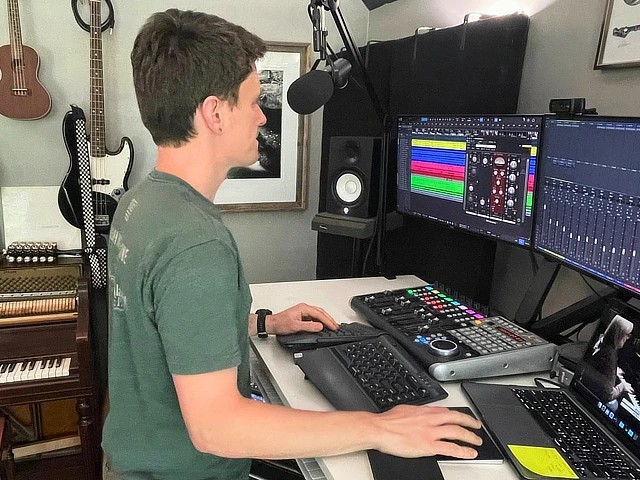
Have you ever been at an event where you couldn’t quite hear the speaker or see them clearly? Or maybe the sound was so off that the message felt lost?
Perhaps you’ve been excited to see some live music, only to find that you couldn’t hear the singer over the drums, and the strobing lights were more distracting than helpful.
In my previous career as an AVL (audio-visual lighting technology) integrator, I worked with many churches that had significant frustrations with their technology. The reasons for these struggles were often multi-faceted: a lack of understanding of the tech, differing opinions on what technology is appropriate for worship, and distraction by unnecessary bells and whistles.
When some people picture AVL in a church, they imagine a “black box” auditorium filled with colorful lights and video walls, resembling a concert venue. This might be off-putting to some, but for others, it may actually help create a worshipful environment. I believe that technology should enhance, not overshadow, the worship experience.
Before making any AVL decisions, it’s essential to define a clear goal for your congregation. What are you trying to achieve with your technology? Whether it’s clearer sound, more engaging visuals, or a more immersive atmosphere, having a defined goal will guide you to smarter tech choices.
In my view, AVL technology can (1) help the speaker or singer be seen and heard more clearly, fostering a deeper human connection; (2) offer new tools to enhance worship; and (3) create an atmosphere of beauty and ambience that supports the worship experience. The first of these (#1) is often universally accepted, while the others (#2-3) may vary in importance depending on the setting, tradition, and congregation.
The Basics: Visibility and Sound
When someone is addressing or leading a crowd, they need to be both seen and heard clearly. Even before technology came into play, Jesus understood this—he found a hill to stand on to make sure the crowd could hear him. Most churches have a good instinct for this, with a stage, chancel, or platform where people can speak and lead music. But unless we’re talking about a house church, we also need to consider sound reinforcement. A properly deployed sound system ensures that everyone, no matter where they’re seated, can clearly hear the speaker or singer. Clear audio helps the congregation focus on the message rather than straining to hear it.
We also need to address front wash lighting. This isn’t about fog machines or lasers. A “front wash” refers to light fixtures aimed at the people on stage, making it easier for the congregation to see the expressions and gestures of worship leaders. This enhances the personal connection and engagement of the worship experience.
Once we’ve established the basics of visibility and sound, we can explore more advanced tools like screens, which can also enhance the worship experience—but only if used intentionally.
Advanced Tools: Screens
Video screens can be a valuable tool for many churches. Displaying song lyrics on the screens helps keep people’s heads up, encouraging them to stay engaged and present in the worship space. However, this might not be as effective for congregations that typically sing in four-part harmony and prefer using hymnals or handouts. Screens can also display sermon graphics and other multimedia that are better suited for digital formats than paper.
When using screens for multimedia, it’s important to be clear on your objective. For example, displaying lyrics and showing a recap video of last month’s mission trip may be perfectly acceptable to some, while others may not appreciate video motion backgrounds. Similarly, some churches with larger spaces may find “IMAG” (short for “Image Magnification,” which shows a magnified camera shot of the speaker) beneficial, while in smaller rooms, it can become a distraction from the live presence of the speaker or worship leader. Just like with screens in our homes and pockets, it’s essential to decide what’s most appropriate for your worship setting.
Atmosphere and Ambience
How do we create and maintain a worshipful atmosphere? If your church has a beautifully ornate vaulted ceiling, architectural uplighting can highlight the space’s beauty, much like the lighting in centuries-old cathedrals. If your church is more of a “black box” auditorium, lighting can be used to transform the space by changing the color of the walls and the overall feel of the room. Thoughtful lighting can enhance the spiritual ambiance without distracting from the worship itself.
Conclusion
When used thoughtfully, AVL technology can greatly enhance the worship experience by helping the congregation see, hear, and connect more deeply with worship leaders. By prioritizing clear communication and using technology appropriately, churches can create an atmosphere that is both engaging and worshipful, supporting the congregation’s spiritual journey. The key is to ensure that the tools used in worship enhance the experience, rather than overshadow it.
Focusing on clarity and connection allows AVL technology to bring congregations closer together, fostering a more meaningful worship experience.
How does your congregation feel about the use of technology in worship? What aspects of worship truly bring your congregation closer to one another and to God? If you’re unsure, that’s a great place to begin. Ultimately, the goal is clear: AVL technology should foster connection—between the congregation and the worship experience, as well as among the worshippers themselves. When used thoughtfully, it can help bring everyone into the fullness of worship
Register by May 15 for Animate 2025 to grow your artistic gifts and deepen your worship understanding. Choose an artistic track and take hands-on Toolbox Classes, including AVL technology sessions with Andrew Henderson, where you'll learn sound, video, lighting, and how to integrate AVL systems into worship. Register today!

Andrew Henderson is a Worship Arts Director and experienced AVL technician with a passion for creating immersive worship experiences. After growing up in Alabama, Andrew studied acoustic guitar, audio engineering, and music production at Appalachian State University, where he met his wife, Michelle. The couple moved to Birmingham after graduation, where they both became deeply involved in their local church, Grace UMC.
Andrew now serves as the Worship Arts Director at Grace, where he leads and trains the church’s mostly volunteer music and tech teams. In addition to his work at Grace, Andrew has run his own company, Lost in Sound, since 2012, providing live event production and AVL integration for churches and venues. He’s worked with various churches, helping them build and optimize their technical setups to enhance worship environments.
Andrew is passionate about teaching and enjoys equipping worship teams with the skills to effectively use AVL systems in ministry. This summer, Andrew will serve as the Tech Director at Animate, overseeing audio, video, and lighting for worship, as well as leading hands-on classes on AVL systems and techniques for campers interested in technical ministry.
When he's not leading worship, training teams, or working events, Andrew enjoys spending time with Michelle and their children, running, and playing music around town.
Explore more posts on planning and designing artistic worship with intention:
Global Worship: Embracing Diversity in Worship Leading
Cultivating the Church Orchestra
Encouraging Participation in Worship
